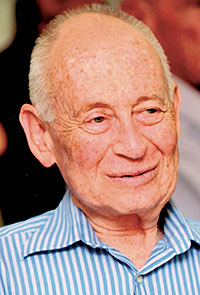Yoseph Imry
DOI: 10.1063/PT.3.4075
Yoseph Imry was a trailblazer in the studies of statistical physics of random systems and quantum phenomena in mesoscopic physics. He received several prestigious prizes, including the 2016 Wolf Prize in Physics. He passed away in Tel Aviv, Israel, on 29 May 2018, following a period of declining health.

Yoseph Imry

Joe, as he was known, was born in Tel Aviv on 23 February 1939. He earned his BSc and MSc from the Hebrew University in Jerusalem and completed his PhD on the dynamics of hydrogen bonds, neutron scattering, and ferroelectric phase transitions at the Weizmann Institute of Science under the supervision of Israel Pelach. After two years as a postdoc at Cornell University, he joined Tel Aviv University in 1969. In 1987 he moved to the Weizmann Institute, where he stayed for the rest of his career.
In the late 1970s, Joe’s study, with Shang-keng Ma, of the effect of quenched randomness on phase transitions was an example of his insightful analysis. Although initially applied to magnetic systems, the Imry–Ma argument has been extended to a broad range of phase transitions. The essence of the argument lies in a comparison between the free energy associated with flipping spin domains and the change in the free energy of the accompanying domain walls. The result was that in low dimensions, an arbitrarily weak random field excludes long-range spin ordering.
Fascinated by what were in the early 1980s new fabrication technologies of submicron electronic devices, Joe turned his attention to the study of quantum phenomena in mesoscopic systems—small devices at the border between the macroscopic and the atomic realms. A pioneer of the field, he made several seminal discoveries. Arguably the most striking was the prediction of persistent currents in mesoscopic metallic rings threaded by magnetic flux. It had been long accepted that superconducting rings carry persistent currents, but Joe’s prediction—that normal metal rings, even imperfect ones, may carry such currents—was a great surprise.
With Rolf Landauer and Markus Büttiker, Joe realized that if the ring was small enough for electrons to maintain their phase coherence while encircling it, the magnetic flux could induce a current-carrying state also in thermodynamic equilibrium. The quantum mechanical nature of that phenomenon was explicitly manifested in its flux periodicity, which shed light on the relation between persistent currents and the Aharonov–Bohm effect. That counterintuitive prediction was initially greeted with skepticism but was soon confirmed experimentally.
Going beyond equilibrium properties, Joe and his collaborators examined the way phase coherence affects transport properties of mesoscopic systems and were able to unravel principles that have since become the standard in the field. They revised Ohm’s law for resistors in series and in parallel for phase-coherent electrons and showed that thermoelectric effects display quantum signatures. Joe elucidated the difference between two-terminal and four-terminal measurements and more generally showed that in phase-coherent systems, measured transport properties, including fundamental ones such as electrical and thermal resistances, depend on the precise experimental configuration.
The development of mesoscopic physics exposed several fundamental questions, and Joe made important contributions toward their resolution. Notable among those were his studies on the fluctuations in electric conductance of mesoscopic samples differing in their disorder’s microscopic details, the relation of those universal fluctuations to random-matrix theory and quantum chaos, and the description of processes in which quantum coherence was lost due to interactions of interfering waves with their environment. In looking at the slow relaxation and aging of electronic Coulomb glasses, he and his collaborators discovered that aging reflected adjustments of domains whose relaxation rate decreased with increasing size. That picture provided a universal description of aging in diverse physical systems.
Besides his direct scientific accomplishments, Joe contributed profoundly to the condensed-matter-physics community, both in Israel and internationally. He was especially influential in advancing experimental research into submicron electronic systems. Most notably, he was the driving force behind the establishment of the Joseph H. and Belle R. Braun Center for Submicron Research at the Weizmann Institute.
Joe was an adviser and a mentor to dozens of Israeli and international scientists. Those who were fortunate to interact with him were influenced by his deep-rooted principles—the importance of theory being closely and interactively relevant to experiments, the importance of backing up mathematical details with clear and lucid physical thinking, and the essential role of both passion and humor when discussing physics. The three of us feel fortunate to be among the many who counted Joe Imry as a mentor, an adviser, a colleague, and most of all, a dear friend. He is profoundly missed.
More about the Authors
Yuval Oreg. Weizmann Institute of Science, Rehovot, Israel.
Ady Stern. Weizmann Institute of Science, Rehovot, Israel.
Uri Sivan. Technion–Israel Institute of Technology, Haifa.
